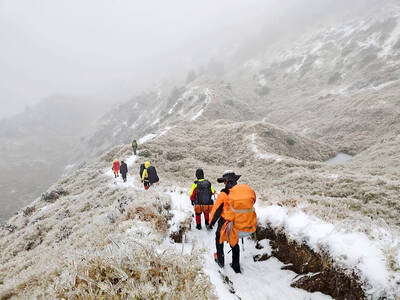After a week-long trip around Taiwan dogged by persistent protests, China’s Association for Relations Across the Taiwan Straits (ARATS) Chairman Chen Deming (陳德銘) returned to Taipei yesterday to attend the annual Cross-Strait CEO Summit — only to be greeted by more demonstrations.
Although the summit purports to facilitate business relationships across the Taiwan Strait, critics say the meeting in effect allows the Chinese Nationalist Party (KMT) and Chinese Communist Party (CCP) to formulate decisions on cross-strait trade policies while circumventing legislative and administrative procedures.
Three separate rallies — led by the Taiwan Solidarity Union (TSU), pro-independence groups and youth activist organizations — took place outside the summit’s venue in Taipei’s Xinyi District (信義), while more than 800 business and political heavyweights from both sides of the Taiwan Strait gathered inside.

Photo: Reuters
Among the attendees at the two-day event are former vice president Vincent Siew (蕭萬長) and former Chinese vice premier Zeng Peiyan (曾培炎), who both spoke at the summit’s opening ceremony.
Business leaders participating in the summit include Jack Ma (馬雲), founder of the Chinese e-commerce giant Alibaba; Sinopec Group senior vice president Dai Houliang (戴厚良); Taiwan Semiconductor Manufacturing Co chairman Morris Chang (張忠謀); and Acer Corp founder Stan Shih (施振榮).
Scuffles with police occurred as protesters from a rally organized by the Taiwan Solidarity Union attempted to inch closer to the venue, resulting in TSU Department of Organization Deputy Director Chang Chao-lin (張兆林) being taken away by police for questioning.
Protesters from a rally led by pro-independence groups congregated across the street, waving towering flags that measured up to three stories high, emblazoned with pro-independence slogans.
A prerecorded track that chanted: “The communist livestock have arrived; the Chinese communist robbers have arrived,” blasted repeatedly through loudspeakers aimed toward the venue.
Economic Democracy Union convener Lai Chung-chiang (賴中強) led a third rally, shouting slogans that denounced participants in the summit as members of the “cross-strait privileged stratum.”
Lai was joined by members of several youth organizations that blossomed following the Sunflower movement in late March and April, in which students and activists occupied the Legislative Yuan’s main chamber for 23 days to protest the government’s handling of a proposed cross-strait service trade agreement.
With important officials from the KMT and the CCP present, Lai said the summit can be seen as an example of the party-to-party negotiation mechanism established during the KMT-CCP forum in 2005, adding that such an arrangement bypasses legal procedures required by Taiwanese law.
The summit touches on many issues that are still under legislative deliberation, Lai said, including draft bills for the proposed free economic pilot zones, as well as cross-strait cooperation in medical and biotechnological industries.
“By conducting negotiations with Chinese authorities without the approval of the Mainland Affairs Council, participants in the summit have broken the law,” Lai said. “Vincent Siew and [former Straits Exchange Foundation chairman] Chiang Pin-kun (江丙坤) should take responsibility for their criminal behavior.”
The protesters offered organizers of the summit a prop of a “moonflower,” referring to Chen’s remarks last week that cautioned against the occurrence of a “Moonflower” movement — a hypothetical sequel to the Sunflower movement — to ensure that the cross-strait trade agreement passes soon.

Trips for more than 100,000 international and domestic air travelers could be disrupted as China launches a military exercise around Taiwan today, Taiwan’s Civil Aviation Administration (CAA) said yesterday. The exercise could affect nearly 900 flights scheduled to enter the Taipei Flight Information Region (FIR) during the exercise window, it added. A notice issued by the Chinese Civil Aviation Administration showed there would be seven temporary zones around the Taiwan Strait which would be used for live-fire exercises, lasting from 8am to 6pm today. All aircraft are prohibited from entering during exercise, it says. Taipei FIR has 14 international air routes and

The Ministry of National Defense (MND) today released images of the military tracking China’s People's Liberation Army (PLA) movements during the latest round of Chinese drills around Taiwan. The PLA began "Justice Mission 2025" drills today, carrying out live-fire drills, simulated strikes on land and maritime targets, and exercises to blockade the nation's main ports. The exercises are to continue tomorrow, with the PLA announcing sea and air space restrictions for five zones around Taiwan for 10 hours starting from 8:30am. The ministry today released images showing a Chinese J-16 fighter jet tracked by a F-16V Block 20 jet and the

Snow fell on Yushan (Jade Mountain, 玉山) yesterday morning as a continental cold air mass sent temperatures below freezing on Taiwan’s tallest peak, the Central Weather Administration (CWA) said. Snowflakes were seen on Yushan’s north peak from 6:28am to 6:38am, but they did not fully cover the ground and no accumulation was recorded, the CWA said. As of 7:42am, the lowest temperature recorded across Taiwan was minus-5.5°C at Yushan’s Fengkou observatory and minus-4.7°C at the Yushan observatory, CWA data showed. On Hehuanshan (合歡山) in Nantou County, a low of 1.3°C was recorded at 6:39pm, when ice pellets fell at Songsyue Lodge (松雪樓), a

NO SHAME IN RETREAT: Hikers should consider turning back if the weather turns bad or if they do not have sufficient equipment, the Taroko park headquarters said Two people died of hypothermia over the weekend while hiking on Hsuehshan (雪山), prompting park authorities to remind hikers to bring proper equipment and consider their physical condition before setting out in the cold weather. Temperatures dropped over the weekend, bringing snow to high altitudes in Shei-pa National Park. One hiker, surnamed Lin (林), who on Friday was traveling with a group of six along the Hsuehshan west ridge trail, lost consciousness due to hypothermia and died, the Shei-pa National Park Headquarters said. On Saturday, another hiker, surnamed Tien (田), in a group of five on the southeast of the west